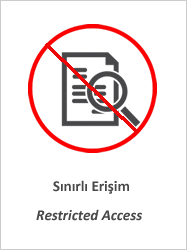SEM (taramalı elektron mikroskobu) görüntülerinin yapay zeka metotları ile incelenmesi
Özet
Günümüzde, Nanoteknoloji ve Nanobilimin, Yapay Zekâ ile çalışma niteliğinin günden güne artması; malzeme biliminin önem kazanmasında etkili olmaktadır. Tezin SEM Görüntülerinin Yapay Zekâ Metotları ile İncelenmesi, multidisipliner bir alanı ifade etmektedir. Tezin içeriği, Nanoteknoloji ve Yapay Zekâ alt başlıklarından oluşmaktadır. Deneysel kısımda kullanılan verilerin oluşumu; halka açık erişim olarak sunulan 22.000 SEM verisinin; Trieste'deki CNR-IOM'un TASC laboratuvarında bulunan ZEISS SUPRA 40 çözünürlüklü cihaz ile 5 yıl boyunca 100 bilim insanının çalışmaları sonucunda elde edildiği bilinmekle birlikte; deneysel çalışma için oluşturulan prototipte yer alan verilerin seçimi için; tek tek çözünürlüğü, görüntü boyutu ve kalitesine göre incelenmesinin ardından, dikkate alınan özellik, görüntü kalitesi olmakla birlikte; bu verilerin oluşumunda 100 görüntü verisi elle manuel olarak nano boyutta ve mikro boyutta seçilip, düzenlendikten sonra; toplamda 1000 görüntü verisi 10 veri seti içerisinde oluşturuldu. Devamında makine öğrenmesi yönteminde yer alan derin öğrenme tekniklerinden CNN sınıflandırma tekniği kullanılarak yapay zekâ eğitimi gerçekleştirildi. Deneysel çalışma için python kütüphanesinden yararlanıldı. Ardından hazırlanan verilerin "RELU-softmax" aktivasyon fonksiyonları ile; Epoch değerleri RMSprop ile 25 ve 100 olarak ayarlanarak eğitim tamamlandı. Bu eğitimde RMSprop yerine, Adam = 0.000001 fonksiyonu kullanılarak tekrar oluşturulan kodlarla, öğrenme hızındaki artış-azalış değerlerini gözlemlemek adına eğitim tekrarlandı. Veri sonuçlarının eğitim parametrelerine uygunluk düzeyine göre sınıflandırma açısından Model doğruluk oranlarının tablolaştırıldı. En iyi sonuç değerinin yorumlaması yapıldı. Burada kullanılan yaklaşım, çok çeşitli nanobilim kullanım durumlarına uygulanabilen, nanomalzemelerin belirli özelliklerini çözmek için uygun parametreler geliştirilecek şekilde ayarlanarak yeni yöntem ve araçların uygulanmasına giden yolu makine öğrenmesinin ürüne dönüşüm boyutunda; malzeme bilimi kütüphanesi oluşturmak amacıyla kullanımının, yapay zekâ ve nanoteknoloji alanındaki gelecek çalışmalarının önünü açabilmesine katkısı olabilir. Today, the quality of Nanotechnology and Nanoscience to work with Artificial Intelligence is increasing day by day; It is effective in gaining importance of materials science. Examination of SEM Images of the thesis with Artificial Intelligence Methods represents a multidisciplinary field. The content of the thesis, It consists of sub-titles of Nanotechnology and Artificial Intelligence. The formation of the data used in the experimental part; 22,000 SEM data available as public access; Although it is known that it was obtained as a result of the work of 100 scientists for 5 years with the ZEISS SUPRA 40 resolution device in the TASC laboratory of CNR-IOM in Trieste; for the selection of data contained in the prototype created for experimental work; After examining the resolution, image size and quality one by one, the feature taken into consideration is image quality; In the formation of these data, after 100 image data are manually selected and arranged in nano and micro dimensions; A total of 1000 image data was created in 10 data sets. Afterwards, artificial intelligence training was carried out using the CNN classification technique, one of the deep learning techniques in the machine learning method. The python library was used for the experimental study. Then, with the "RELU-softmax" activation functions of the prepared data; the training was completed by setting the epoch values to 25 and 100 with RMSprop. In this training, the training was repeated to observe the increase- decrease values in the learning speed with the renewed codes using the Adam=0.000001 function instead of RMSprop. Model accuracy rates are tabulated in terms of classification according to the level of fit of data results with training parameters. The interpretation of the best result value was made. The approach used here is in the machine learning-to-product dimension, which leads to the application of new methods and tools by adjusting to develop appropriate parameters to solve specific properties of nanomaterials, which can be applied to a wide variety of nanoscience use cases; Its use to create a materials science library may contribute to paving the way for future studies in the field of artificial intelligence and nanotechnology.
Koleksiyonlar
- Tez Koleksiyonu [240]


















